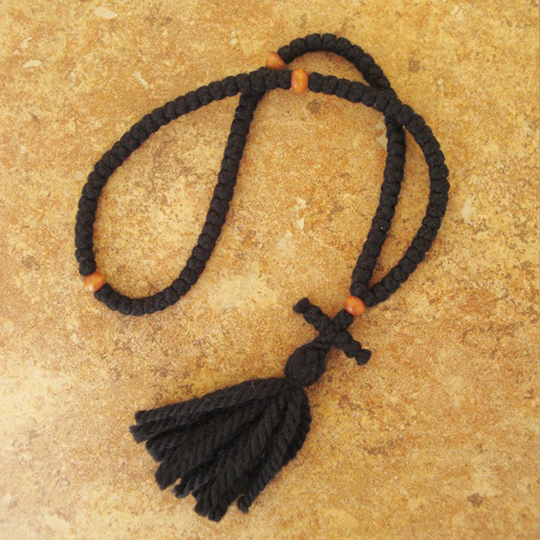|
||||||||||||

A Greek prayer rope or komboskini, used for chanting the Jesus Prayer. Prayer ropes such as this may have been early ancestors of the Catholic Rosary.
How to Say the Jesus Prayer
The Jesus Prayer can be recited in full, or in various abbreviated versions. The full version, in English, is:
| Lord Jesus Christ, Son of God, have mercy on me, a sinner. |
Personally, I like to chant this prayer in Greek because the Jesus Prayer came to us through the Greek New Testament. In accordance with the inflections of Greek grammar, the wording differs slightly, if said by a man or woman. Here is the Jesus Prayer in Greek:
FOR MEN
 |
FOR WOMEN
 |
In the Latin alphabet, we would spell these prayers as follows:
FOR MEN
| Kyrie Iesou Christe, Yie tou Theou, Eleison me ton amartolon. |
FOR WOMEN
| Kyrie Iesou Christe, Yie tou Theou, Eleison me tin amartolon. |
We would pronounce them something like this:
FOR MEN
| KEE-ree-ay ee-SOO khree-STAY, YAY too thay-OO, eh-lay-ee-SOHN meh TOHN ah-mar-toh-LOHN |
FOR WOMEN
| KEE-ree-ay ee-SOO khree-STAY, YAY too thay-OO, eh-lay-ee-SOHN meh TEEN ah-mar-toh-LOHN |
“The Rosary belongs among the finest and most praiseworthy traditions of Christian contemplation. Developed in the West, it is a typically meditative prayer, corresponding in some way to the ‘prayer of the heart’ or ‘Jesus prayer’ which took root in the soil of the Christian East.” Pope John Paul II, “Rosarium Virginis Mariae“, October 16, 2002
History of the Prayer
Early Christians in the East adapted the Jesus Prayer from a passage in the Parable of the Pharisee and the Publican, which Jesus told in Luke 18:9-14. The parable appears below in Greek and English, with the pertinent words shown in red.
|
9 Εἶπεν δὲ καὶ πρός τινας τοὺς πεποιθότας ἐφ’ ἑαυτοῖς ὅτι εἰσὶν δίκαιοι καὶ ἐξουθενοῦντας τοὺς λοιποὺς τὴν παραβολὴν ταύτην· 10 ἄνθρωποι δύο ἀνέβησαν εἰς τὸ ἱερὸν προσεύξασθαι [ὁ] εἷς Φαρισαῖος καὶ ὁ ἕτερος τελώνης. 11 ὁ Φαρισαῖος σταθεὶς (ταῦτα) πρὸς ἑαυτὸν [ταῦτα] προσηύχετο· ὁ θεός, εὐχαριστῶ σοι ὅτι οὐκ εἰμὶ ὥσπερ οἱ λοιποὶ τῶν ἀνθρώπων, ἅρπαγες, ἄδικοι, μοιχοί, ἢ καὶ ὡς οὗτος ὁ τελώνης· 12 νηστεύω δὶς τοῦ σαββάτου, ἀποδεκατεύω / ἀποδεκατῶ πάντα ὅσα κτῶμαι. 13 ὁ δὲ τελώνης μακρόθεν ἑστὼς οὐκ ἤθελεν οὐδὲ τοὺς ὀφθαλμοὺς ἐπᾶραι εἰς τὸν οὐρανόν, ἀλλ’ ἔτυπτεν τὸ στῆθος ἑαυτοῦ / αὐτοῦ λέγων· ὁ θεός ἱλάσθητί μοι τῷ ἁμαρτωλῷ. 14 λέγω ὑμῖν, κατέβη οὗτος δεδικαιωμένος εἰς τὸν οἶκον αὐτοῦ παρ’ ἐκεῖνον· ὅτι πᾶς ὁ ὑψῶν ἑαυτὸν ταπεινωθήσεται, ὁ δὲ ταπεινῶν ἑαυτὸν ὑψωθήσεται. |
[9] And he spake this parable unto certain which trusted in themselves that they were righteous, and despised others: [10] Two men went up into the temple to pray; the one a Pharisee, and the other a publican. [11] The Pharisee stood and prayed thus with himself, God, I thank thee, that I am not as other men are, extortioners, unjust, adulterers, or even as this publican. [12] I fast twice in the week, I give tithes of all that I possess. [13] And the publican, standing afar off, would not lift up so much as his eyes unto heaven, but smote upon his breast, saying, God be merciful to me a sinner. [14] I tell you, this man went down to his house justified rather than the other: for every one that exalteth himself shall be abased; and he that humbleth himself shall be exalted. |
Through this parable, Jesus illustrates the proper way to approach God in prayer. The Pharisee prays badly, congratulating himself on his righteousness. The Publican, on the other hand, begs God for mercy, knowing himself to be a sinner. Jesus commends the prayer of the Publican, who cries, “God, have mercy on me, a sinner!” (as translated in the NIV or New International Version of the Bible). These words became the basis of the Jesus Prayer.
Pray Without Ceasing
In obedience to St. Paul’s instruction to “Pray without ceasing” (I Thessalonians 5:17), the early Christian monks of Egypt used to chant verses from Scripture, repeating them over and over again, as a form of meditation. The Jesus Prayer probably grew out of this practice.
In time, the monks and hermits of Eastern Christendom developed the habit of reciting specific numbers of Jesus Prayers (such as 33 or 100). They would keep track of these prayers by counting off knots on a woolen cord. Some scholars believe that these primitive “prayer ropes” were early ancestors of the Latin Rosary.
Tradition holds that St. Pachomios the Great (circa 292-346 AD) — a monk living in the Egyptian desert — made the first “prayer rope“, inspired by a dream.
To this day, Greek Orthodox monks still recite the Jesus Prayer on a knotted prayer rope which they call the Komboskini (Κομποσκοίνι).
Greek worshippers often use abbreviated forms of the Jesus Prayer, such as, “Lord have mercy” (Kyrie eleison). This version of the Jesus Prayer found its way into the Catholic liturgy, in the form of the so-called Kyrie. In the traditional Catholic Mass, the Kyrie is sung in this manner:
Kyrie eleison
Kyrie eleison
Kyrie eleison
Christe eleison
Christe eleison
Christe eleison
Kyrie eleison
Kyrie eleison
Kyrie eleison
In memory of its origin in the Greek-speaking east, the Kyrie is the only part of the traditional Catholic Mass prayed in Greek rather than Latin. To hear the Kyrie sung in Gregorian chant, play the video below:
The Russian Jesus Prayer – Иисycoва молитва
Sung by the sisters of St. Elizabeth Monastery, Belorussia
Поют сестры монастыря Св. Елизаветы. Белорусия
Version 1
Господи Иисусе Христе, Сыне Божий, помилуй мя грешнаго (грешную for a woman).
Version 2
Адонай ЯХВЕ, помилуй мя грешнаго (грешную for a woman).
(Адонай ЯХВЕ = Adonai Yahweh)
Version 3
Господи, помилуй
“St. Pachomius“, The Catholic Encyclopedia
“Pachomius“, wikipedia.org, retrieved September 9, 2007
“Prayer Rope“, wikipedia.org, retrieved September 9, 2007
“Kyrie“, wikipedia.org, retrieved September 9, 2007
“Hesychasm“, wikipedia.org, retrieved September 9, 2007
“Jesus Prayer“, wikipedia.org, retrieved September 9, 2007
Komboskini images
Prayer of the Heart
The Jesus Prayer
Jesus Prayer – Prayer of the Heart
